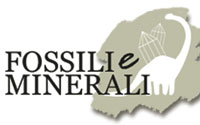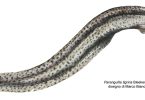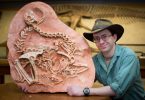Ricostruito con dettagli senza precedenti il piu’ giovane, piccolo e completo scheletro fossile di un iconico rettile con la cresta, il parasaurolophus, dinosauro erbivoro appartenente alla famiglia degli adrosauridi. Lo scheletro e’ stato scoperto da uno studente di liceo, Kevin Terris, all’interno del Grand Staircase Escalante-National Monument nello Utah meridionale.
Il campione non era stato notato dai paleontologi professionisti negli scavi effettuati tra le ossa rilevate nell’area. Il dinosauro e’ stato soprannominato Joe. L’animale viveva attraverso ilNord America occidentale circa settantacinque milioni di anni fa. Un parasaurolophus bambino che mori’ a meno di un anno di eta’. Il fossile rivela che la specie sviluppava in fase adulta l’inusuale cresta ampliando alcune ossa del cranio prima e per un periodo di tempo piu’ lungo rispetto ai suoi parenti stretti. Lo scheletro di Joe e’ descritto da modelli 3D e scansioni di ogni minima caratteristica della sua anatomia: un completo dinosauro digitale disponibile per il download. Il lavoro e’ stato promosso dalla Webb Schools in California e pubblicato sulla rivista ad accesso libero PeerJ.
Ontogeny in the tube-crested dinosaurParasaurolophus (Hadrosauridae) and heterochrony in hadrosaurids
Andrew A. Farke, Derek J. Chok, Annisa Herrero, Brandon Scolieri,Sarah Werning
Abstract
The tube-crested hadrosaurid dinosaur Parasaurolophus is remarkable for its unusual cranial ornamentation, but little is known about its growth and development, particularly relative to well-documented ontogenetic series for lambeosaurin hadrosaurids (such asCorythosaurus, Lambeosaurus, and Hypacrosaurus). The skull and skeleton of a juvenile Parasaurolophus from the late Campanian-aged (∼75.5 Ma) Kaiparowits Formation of southern Utah, USA, represents the smallest and most complete specimen yet described for this taxon. The individual was approximately 2.5 m in body length (∼25% maximum adult body length) at death, with a skull measuring 246 mm long and a femur 329 mm long. A histological section of the tibia shows well-vascularized, woven and parallel-fibered primary cortical bone typical of juvenile ornithopods. The histological section revealed no lines of arrested growth or annuli, suggesting the animal may have still been in its first year at the time of death. Impressions of the upper rhamphotheca are preserved in association with the skull, showing that the soft tissue component for the beak extended for some distance beyond the limits of the oral margin of the premaxilla. In marked contrast with the lengthy tube-like crest in adult Parasaurolophus, the crest of the juvenile specimen is low and hemicircular in profile, with an open premaxilla-nasal fontanelle. Unlike juvenile lambeosaurins, the nasal passages occupy nearly the entirety of the crest in juvenile Parasaurolophus. Furthermore, Parasaurolophus initiated development of the crest at less than 25% maximum skull size, contrasting with 50% of maximum skull size in hadrosaurs such as Corythosaurus. This early development may correspond with the larger and more derived form of the crest in Parasaurolophus, as well as the close relationship between the crest and the respiratory system. In general, ornithischian dinosaurs formed bony cranial ornamentation at a relatively younger age and smaller size than seen in extant birds. This may reflect, at least in part, that ornithischians probably reached sexual maturity prior to somatic maturity, whereas birds become reproductively mature after reaching adult size.
Farke AA, Chok DJ, Herrero A, Scolieri B, Werning S. (2013) Ontogeny in the tube-crested dinosaur
Parasaurolophus (Hadrosauridae) and heterochrony in hadrosaurids. PeerJ 1:e182
http://dx.doi.org/10.7717/peerj.182










